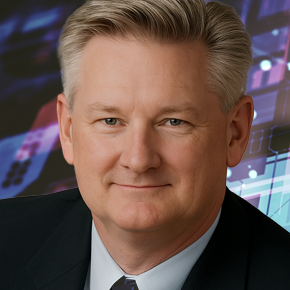April 26, 2024
A Consultant’s Advice on Change Management

Transcript
For manufacturers to truly take advantage of digital transformation, they not only need good software solutions, they need a change management strategy to ensure that business processes and the people involved with them adapt at an equal rate to technological change.
Many large manufacturers look to consulting services to help with process optimization, product strategy, and strategic change management. Consultants work with internal teams, lead stakeholders through strategic planning and ensure that the new technology really makes the business more agile and adaptable.
But whether or not you can engage a Change Management Consultant, anyone regardless of job title can be a change leader and help realize the benefits of digital transformation. My guest today, Craig Melrose, made a name for himself implementing change at Toyota with strategic process optimizations that hit the bottom line. Not an easy thing to do at Toyota, a company that pioneered continuous change management in the form of Six Sigma. After Toyota, Craig moved on to McKinsey where he worked with half of the Fortune 500 companies, orchestrating change that either saved or generated multiple billions of dollars. Now after decades of management consulting, Craig works with PTC as a leader of digital business transformation. Craig Melrose welcome to the podcast.
How Does a Consultant Think about Change Management?
Craig Melrose: Thank you, Leah. It’s hard to live up to that introduction, but I’ll say this about change management: It is about changing business—making business better. There are a lot of tools: Lean, Six Sigma, digital. But it’s about the results, not about the inputs. Change management is a concept of what the goal is, what the gap is, and how we are going to close that gap.
3 Questions Make Up Change Management
- What is the goal?
- What is the gap?
- How are we going to close that gap?
Goals of Change Management
Leah Archibald: Now when you talk about the goal, Is it always the same kind of goal? Is it: We want to save X amount of dollars? Or we want to make X amount of dollars? Or is it market share, process improvement, or time to market? Or is it different from company to company?
Craig Melrose: To me, it’s always a business transformative goal. Typically that’ll be a significant cost reduction, I think in terms of double-digits, so a 10% or greater cost reduction, or a 10% or greater improvement in capacity, which is just new revenue. But it also could be 10% or greater speed to market, or time to launch a new product. All of those are business impacts.
What I think frustrates teams, and where sometimes people fall short, is when they’re measuring a percent of something and they say: We want to get 5% better than what we are today. Well, how do you measure that? At the end of 5%, is it worth one million, 10 million, or 100 million? If you don’t know, then it’s hard to know if you’ve actually been successful.
Leah Archibald: And I imagine part of your consulting engagement starts with getting the metrics right. Because you may go in and the company has one idea of metrics, and you might say: Well, we can’t really measure that, but what is a proxy for that?
Link Operational to Financial Metrics
Craig Melrose: Right! And this is the thing one that most organizations miss, linking an operational metric to a financial metric. That typically doesn’t match up very well, so you have lots of operational metrics, and at the end of the day, I think organizations feel like, If I just achieve these metrics, hopefully, there’s a business impact. But they’re not able to define it as one-to-one. That’s not a way to achieve a business goal.
Leah Archibald: Can you give an example from your consulting career of a company where you went in and they had one metric in mind and you had to help them tease out how that related to the bottom line?
Craig Melrose: It happens in manufacturing all the time. One example could be quality. A lot of times organizations will say: Okay, my first pass quality is 97%. Okay, I want to move into 98%. One percentage point. But what does that mean in terms of financial impact? They may not link it back to 97% means 970 units and 98% means 980 units. So, the difference is 10 units, and then if I’m not throwing away those 10 units, each unit is worth $100,000. So now those 10 units is worth a million dollars. It’s easier to do that with quality, as I just described, but as soon as you take that a step away from material and go to people, it gets difficult. Now I have a factory with 1000 people building those 970 units or building those 980 units. Well, if I make an improvement, do those thousand people make 980 units or do those thousand people stop working over-time on the weekend? There are so many different variables, and each one has a different cost or value from a business standpoint.
Leah Archibald: So I’m hearing you talk about trade-offs, and a lot of a consultant’s role is to come in and lay on the table the trade-offs that a company is making that you maybe don’t see that you’re making. Often with the aPriori software we’ll engage a customer and they’ll be trying to hit a quality threshold that’s actually not necessary for the performance of their product. So they’ll say: This part needs to be produced within this level of tolerance, and we’ll say actually it’s going to function if the tolerance is a little less. You can use a different machine, you can use a different process.
That’s a very granular example, but I think often the conversation gets dropped between the product development team and the manufacturing team. And you need to have someone in the middle doing the communication between the two, whether that’s a consultant’s role or that’s a software solution.
Craig Melrose: You just picked a perfect one Leah. Let’s take that one to ground. Engineers are wonderful people. I am one, right? But an engineer’s mindset is around precision and design and functionality. And so a design engineer will currently build it to one one-thousandth of an inch precision. By the time that makes it to manufacturing, the engineers is not going with it, and then manufacturing is sitting there saying: What were those engineers thinking? They’ve created something that is so complex, I have to do all this additional value-add. I need extra machines, I need extra vision and quality checks, I need extra testing. And it’s adding all of this cost and complexity in manufacturing. Well, they’re separated physically, but typically the separation is more about time. It was designed a year ago, and now that designer’s on to something different. But it’s now being manufactured today a year later, and so then suddenly it’s like: Well, this is what we’ve inherited, just make it as good as possible.
It takes a leadership team and sometimes an outsider like a consultant to be unbiased and zoom out and say: Well, if we had relaxed that quality restraint or dimension, we could then change all of this cost and make it a simpler product. Would that harm the customer’s use of that product or the customer’s satisfaction or their impression of us as a company because of the quality of the product? If the answer is no to all of those, then let’s simplify the design because it’s going to take cost out in manufacturing. But that connection often isn’t happening.
Much like the connection we talked about relating operational metrics to business goals, this is the same thing. But here the missed connection is across silos and across time, which makes it even more complicated to match up.
Leah Archibald: I think there are a couple of ways to address this problem, and I’m going to bring this back to digital transformation. There are a couple of ways to try to get engineers and manufacturing connected, and one way is to have a digital thread going through manufacturing to engineering where there’s not this step where a disconnect happens. Another way to help design engineers get visibility into the future steps of the process is to have a smart software solution at the beginning of the design process so they can see the trade-offs between cost and manufacturability.
But for that to happen, there’s a lot of layers of digitization that has to happen first. Like this is almost the first step of the consulting process.
Craig Melrose: Absolutely. I think part of the challenge is that without digital, the approach is good behavior. It requires me to seek out the rules. So, imagine 100 engineers are designing a product, and all of them have a different sub-assembly. Well, each one of them might decide to use a different sized fastener bolt screw. So suddenly now we have 200 different size screws where one person could have zoomed out and said: Let’s all use one size and consolidate. But that takes somebody thinking about getting ahead of the challenge. And sometimes that’s rules based. Sometimes that’s historical. But it’s a lot of good behavior.
Create Rules that Never Sleep
What digital allows is create those rules that never go to sleep. A digital solution says: Ok engineer, if you want to design this part well you have to use this screw. And if you don’t want to use this screw, you have to request a change, and somebody needs to approve that.
The intent of having that rule is to minimize cost, and to make it simpler both to purchase those products and also to manufacture those products. So digital is helping to make the good behavior easier to follow because the rule never sleeps.
I think that’s the real power behind systems like aPriori. It’s bringing best practices, but it’s also locking those best practices in place, and both of those are absolutely critical to get the right behavior.
Take, for example, in the US, if the National Transportation and Safety Board had to send an email out to everyone about when you come to two roads that cross, stop, that’s not going to work. Instead, we have to put up these red signs that say, Stop in all caps. Or a red light.
Leah Archibald: Let’s stay with this example, but go from cars to say car parts.
Craig Melrose: Absolutely. So let me give you an example. I worked with a German automotive company, very engineering-oriented, and very precise. Well, the headrest had two metal hosts for the headrest to go down into the seat. And on the seat side, there’s a little piece that has to receive that metal post. It has notches, and it allows you to adjust the headrest up two or three notches or down two or three notches or whatever you want. Everybody sees that – they don’t think about it as a consumer. But an engineer is looking at that and saying, Okay, well, to catch that headrest post and lock into that notch, I need to design something that’s very strong and robust.
Over time, this German company had designed a receiver for that post that was about two inches long, it was about three quarters of inch square, and it had a scissor mechanism on it to lock in on the notch and hold the notch so that the headrest was very secure. Great design, probably a superior design for that function over anything in the world. But was it required?
When we looked at some Asian automotive companies and some US automotive companies, we found that they were just using a spring and a wedge. And the design difference was a dollar or $2 per headrest receiver.
Leah Archibald: That’s a lot. That’s two dollars per seat times the number of seats in a vehicle.
Craig Melrose: You’ve got two per seat times five seats, because typically there’s a middle headrest in the back, so that’s two times five, 10, per vehicle. That’s $10 a vehicle, millions of vehicles per year, so you get tens of millions of dollars just on changing something that the customer never sees, and the competition had a simpler design has never had a quality issue or a complaint. So the savings came from understanding the non-critical elements.
I’ll give another example from when I was at Toyota with Lexus. The Lexus automatic gear shift was actually more expensive than all of the other luxury vehicles. But their thought process was: I want it to feel extremely robust, and I want it to shift smoother and more solidly than any of the competition, because it’s one of the few places that a customer interacts with the vehicle. So, when I shift the car, I feel like it’s a luxury. Let’s say this gear shift was $100 extra over all the other competitors. Toyota didn’t just say: Well, that’s $100 that we’re gonna lose. Toyota said: Well, let me look at everything on the vehicle that the customer never sees, and take $100 out. Or take $200 out so that I can make even more margin.
So there was this trade-off of what matters. There was a felt need for the shifter to be more expensive, but there was not a need for the cost to stay the same throughout the entire vehicle.
10x Software-to-Value Ratio
Leah Archibald: To sum up, I’d say: you don’t know what you don’t know. You don’t know what you could save by engaging a consultancy, and you don’t know what you could save by purchasing a software solution. How do you communicate the value, both of consulting services and of the overall digitization program?
Craig Melrose: Typically, what I’ve seen in software-to-value is about 10 to one or greater. Meaning, I pay one for the software, but I achieve 10 x in value at the company. And so it pays for itself for 10 years with one idea. Things like aPriori – where you’re looking at the value of the material, which is about half of what you spend your money on, it pays for itself.








